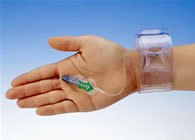
|
Although it is usually benign for the patient, it precludes future radial access. For example, if the radial artery occludes after a diagnostic catheterization, any subsequent PCI procedures must be done via the femoral artery. Pancholy's work has been ground-breaking, in that it discovered one of the primary causes of radial artery occlusion: rapidly-organizing thombus. Almost by accident, Pancholy confirmed what many had hypothesized (he describes the incident in detail in our exclusive interview): namely, that a major cause of radial artery occlusion is blood clotting that occurs during hemostasis of the radial artery. Occlusive pressure for long periods of time certainly stops any bleeding, but pressure that is too compressive for too lengthy a period of time can cause blood clotting that occludes the radial artery.
To test this hypothesis, Pancholy and colleagues established a protocol for monitoring radial artery patency during hemostasis using pulse oximetry, to make sure the radial artery is not being compressed occlusively. He calls this "guided compression", utilized to achieve "patent hemostasis". The results of the initial study, titled PROPHET, were recently published online in Catheterization and Cardiovascular Interventions. The study showed that monitoring the patency of the radial artery during hemostasis, and reducing compression accordingly, resulted in a significant reduction in radial artery occlusion. But there are a number of methods for achieving hemostasis in a radial procedure. Pancholy looked at data from his own lab and saw that patients on whom he had used the TR Band, as opposed to the commonly-used HemoBand, had significantly lower rates of radial artery occlusion. So Dr. Pancholy devised a randomized clinical study to test the efficacy of the TR Band in preventing radial artery occlusion. 500 consecutive patients undergoing transradial catheterization were prospectively enrolled in the study. 250 consecutive patients received hemostasis by application of HemoBand (Group I) and the next 250 patients received hemostasis using the inflatable TR band (Group II). Radial artery patency was studied the time of application of the hemostasis device, at 30 minutes, 60 minutes and at 24 hour and 30 days using Barbeau’s test.
His explanation of the results can be read in detail in Dr. Pancholy's interview, but the bottom line is that the TR Band automatically and incrementally lowers the occlusive pressure on the radial artery over a two hour period and results in a significant reduction of occlusion. The take-away from Pancholy's studies is that when achieving hemostasis in a radial procedure, longer and stronger compression, commonly used for the femoral artery, is counter-productive and results in higher rates of radial artery occlusion.
Reported by Burt Cohen, November 11, 2008 |


